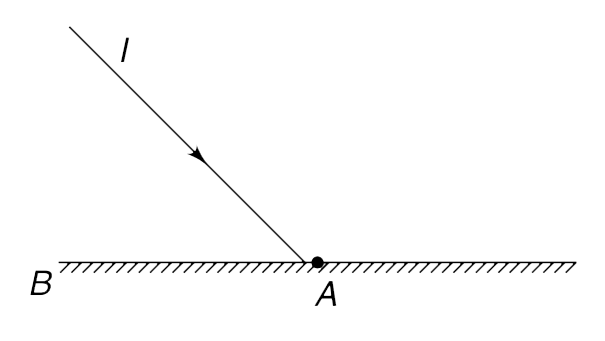A plane mirror reflecting a ray of incident light is rotated through an angle q about an axis through the point of incidence in the plane of the mirror perpendicular to the plane of incidence, then
(1) The reflected ray rotates through an angle 2q
(2) The incident ray is fixed
(3) The reflected ray does not rotate
(4) The reflected ray rotates through an angle q
The reflected ray does not rotate
The reflected ray rotates through an angle θ
The reflected ray rotates through an angle 2θ
The incident ray is fixed
The correct Answer is:c, d
Step by step video, text & image solution for A plane mirror reflecting a ray of incident light is rotated through an angle q about an axis through the point of incidence in the plane of the mirror perpendicular to the plane of incidence, then (1) The reflected ray rotates through an angle 2q (2) The incident ray is fixed (3) The reflected ray does not rotate (4) The reflected ray rotates through an angle q by Physics experts to help you in doubts & scoring excellent marks in Class 12 exams.
Topper's Solved these Questions
- BOOK - ERRORLESS CHAPTER - RAY OPTICSEXERCISE - Refraction of Light at Plane Surfaces9videos
RAY OPTICS
- BOOK - ERRORLESS CHAPTER - RAY OPTICSEXERCISE - Refraction at Curved Surface8videos
RAY OPTICS
- BOOK - ERRORLESS CHAPTER - MAGNETISMEXERCISE - Assertion & Reason1videos
MAGNETISM
- BOOK - ERRORLESS CHAPTER - WAVE OPTICSEXERCISE - SET23videos
WAVE OPTICS
Similar Questions
For a fixed incident light ray, if the mirror be rotated through and angle θ (about an axis which lies in the plane of mirror and perpendicular to the plane of incidence), show that the reflected ray turns through an angle 2θ in same sense.
View SolutionWhat is the angle of incidence of a ray if the reflected ray is at an angle of 90∘ to the incident ray?
View Solution
Knowledge Check
- Question 1 - Select One or More
A plane mirror, reflecting a ray of incident light, is rotated through an angle θ about an axis through the point of incidence in the plane of the mirror perpendicular to the plane of incidence, then
AThe reflected ray does not rotateBThe reflected ray rotates through an angle θCThe reflected ray rotates through an angle 2θDThe incident ray is fixed - Question 2 - Select One
A plane mirror, reflecting a ray of incident light, is rotated through an angle θ about an axis through the point of incidence in the plane of the mirror perpendicular to the plane of incidence, then
AThe reflected ray does not rotate.BThe reflected ray rotates through an angle θ.CThe reflected ray rotates through an angle 2θ.DNone of these - Question 3 - Select One
A plane mirror reflecting a ray of incident light is rotated through an angle of 30∘ about an axis through the point of incidence in the plane of the mirror and perpendicular to the plane of incidence then
Athe incident ray is fixedBthe reflected ray rotates through an angle θCthe reflected ray rotates through an angle θ/2Dthe reflected ray rotates through an angle of 2θ
When a light ray is incident normally on the surface of a plane mirror, the reflected ray deviates through an angle of ________
View SolutionI is a ray incident on a plane mirror. Keeping the incident ray fixed, the mirror is rotated by an angle θ about an axis passing through A perpendicular to the plane of the Fig. show that the refracted ray rotates through an angle 2θ. Does your answer differ if the mirror is rotated about an axis passing through B?
 View Solution
View SolutionWhat is the angle of incidence of a ray if the reflected ray is at an angle of 90∘ to the incident ray?
View SolutionWhen mirror is rotated through an angle θ, a reflected ray from it moves through an angle of
View SolutionA ray of light falls on a plane mirror. When the mirror is turned, about an axis at right angle to the plane of the mirror through 20∘, the angle between the incident ray and new reflected ray is 45∘. Find the angle between the incident ray and original reflected ray.
View Solution

